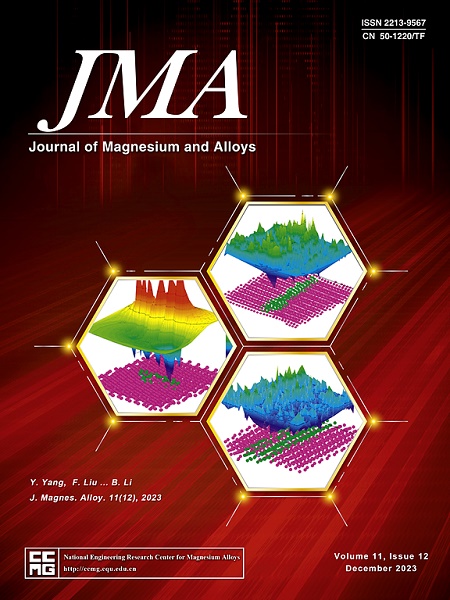Wire arc additive manufacturing of a novel ATZM31 Mg alloy: Microstructure evolution and mechanical properties
IF 15.8
1区 材料科学
Q1 METALLURGY & METALLURGICAL ENGINEERING
引用次数: 0
Abstract
The preparation of large-scale magnesium (Mg) alloy parts by wire arc additive manufacturing (WAAM) has broad application prospects, including automotive and aerospace industries. The chemical composition of Mg alloy wires plays a critical role in determining mechanical properties of WAAM Mg alloys. However, types of Mg alloy wires for WAAM need to be extended, in order to improve mechanical properties. Therefore, in the present work, a novel ATZM31 Mg alloy wire has been prepared and applied to the cold metal transfer (CMT)-WAAM process. This study focuses on understanding the forming quality, microstructure evolution, and mechanical properties of the ATZM31 alloy thin-wall component fabricated by WAAM. The results show that the Mg alloy thin-wall component possesses satisfactory formability, with minor sidewall roughness. The ATZM31 thin-wall component is mainly composed of columnar dendrites and equiaxed dendrites of the α-Mg phase, with the η-Al8Mn5 phase distributes dispersedly at grain boundaries. The area fraction of the η-Al8Mn5 phase is estimated to be ∼0.21% based on the statistical analysis of SEM images. Due to different cooling behaviors, the distribution of grain size along the build direction of the thin-walled component is uneven. The average grain size is ∼46 µm, ∼74 µm and ∼61 µm at the bottom, middle and top of the ATZM31 alloy thin-wall component, respectively. From the substrate to the top of the ATZM31 alloy thin-wall component, the hardness decreases gradually. The ultimate tensile strength along the deposition direction and build direction are ∼225 MPa and ∼214 MPa, respectively, without pronounced anisotropy. The ATZM31 alloy thin-wall component fabricated by WAAM exhibits a comparable ultimate tensile strength to forged AZ31 Mg alloys and weaker anisotropy than wrought Mg alloys.
新型ATZM31镁合金的电弧增材制造:组织演变与力学性能
电弧增材制造技术(WAAM)制备大型镁(Mg)合金零件具有广阔的应用前景,包括汽车和航空航天工业。镁合金丝的化学成分对WAAM镁合金的力学性能起着至关重要的作用。然而,用于WAAM的镁合金丝的类型需要扩展,以提高机械性能。因此,本文制备了一种新型的ATZM31镁合金丝,并将其应用于冷金属转移(CMT)-WAAM工艺。研究了WAAM工艺制备ATZM31合金薄壁件的成形质量、组织演变和力学性能。结果表明:镁合金薄壁件具有良好的成形性能,侧壁粗糙度较小;ATZM31薄壁组分主要由α-Mg相的柱状枝晶和等轴枝晶组成,η-Al8Mn5相分散分布在晶界处。根据SEM图像的统计分析,估计η-Al8Mn5相的面积分数为~ 0.21%。由于不同的冷却行为,薄壁构件沿构建方向的晶粒尺寸分布是不均匀的。ATZM31合金薄壁构件底部、中部和顶部的平均晶粒尺寸分别为~ 46µm、~ 74µm和~ 61µm。从基体到ATZM31合金薄壁件顶部,硬度逐渐降低。沿沉积方向和构筑方向的极限拉伸强度分别为~ 225 MPa和~ 214 MPa,无明显的各向异性。WAAM制备的ATZM31合金薄壁构件的极限抗拉强度与锻态AZ31镁合金相当,各向异性比锻态镁合金弱。
本文章由计算机程序翻译,如有差异,请以英文原文为准。
求助全文
约1分钟内获得全文
求助全文
来源期刊

Journal of Magnesium and Alloys
Engineering-Mechanics of Materials
CiteScore
20.20
自引率
14.80%
发文量
52
审稿时长
59 days
期刊介绍:
The Journal of Magnesium and Alloys serves as a global platform for both theoretical and experimental studies in magnesium science and engineering. It welcomes submissions investigating various scientific and engineering factors impacting the metallurgy, processing, microstructure, properties, and applications of magnesium and alloys. The journal covers all aspects of magnesium and alloy research, including raw materials, alloy casting, extrusion and deformation, corrosion and surface treatment, joining and machining, simulation and modeling, microstructure evolution and mechanical properties, new alloy development, magnesium-based composites, bio-materials and energy materials, applications, and recycling.
 求助内容:
求助内容: 应助结果提醒方式:
应助结果提醒方式:


